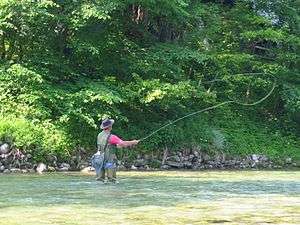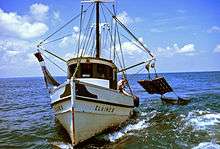Fly tying
Fly tying is the process of producing an artificial fly used by fly fishing anglers to catch fish.
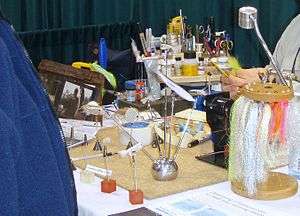
Helen Shaw, an American professional fly tyer, defined it as the "simple [sic] process of binding various materials to a hook with thread".[1] However, thread is no longer always necessary since modern materials such as UV-cured resins can be used to fix the materials to the hook.
Fly tying requires some basic equipment,a vise to hold the hook, bobbins, pliers and the appropriate materials for the particular fly pattern selected. This consists mostly of feathers and hairs, nowadays also synthetic materials. Fly tying equipment enables the fly tyer to efficiently and effectively assemble and secure the materials on the hook. Fly tying materials were originally limited to various furs, feathers, threads and hooks. Today, many more natural and synthetic materials are used to tie flies.[2] Fly patterns are the instructions or recipe required to create the fly. They specify hook sizes and types, the materials and colors to be used, as well as the sequence to be followed and the assembly methods. There are thousands of possible fly patterns available to the tyer.
Hand-tied flies on the commercial market sell for under a US dollar to several US dollars each. Fly tying is a challenging and rewarding hobby for some, a money-saving strategy for others, and a profitable commercial enterprise for the professional tyer. The professional or commercial fly tyer may produce upwards of 36 thousand flies annually, whereas the amateur fly tyer may tie only a few flies each season for personal use.[3]
Approach
Some view fly tying as an art form. E. C. Gregg, in his 1940 publication, stated that "The object of this book will be throughout its entirety to teach in a practical manner the Art of Fly Tying in all its branches."[4]
In contrast, A. K. Best suggests practical ways to streamline the tying technique.[5] Best emphasizes that fly tying is not only a handicraft but also a science rooted in carefully observing fish and their prey, and then designing and tying artificial flies to replicate that prey in order to catch fish. One of the first contributions to this approach was made by Preston Jennings in his A Book of Trout Flies.[6]
Fly tying history
The history of fly tying (and fly design) reflects the evolution and history of fly fishing. Basic fly-tying methods have not changed dramatically from the mid-19th century to the present. Most changes resulted from the introduction and adaptation of new materials, especially synthetics, and new hook designs. Images from the early literature devoted to fly tying and fly construction do not show processes significantly different from those used today. The tools associated with fly tying today have, however, evolved along with new technologies. In the mid-19th century flies were tied without benefit of a hook vise. Instead, the hook was held by the fingers as the fly was constructed. The following is from Rod Fishing in Clear Waters (London 1860):
Your materials being now in a state of readiness, the hook must be first tied on with waxed silk to the finest end of the hair or gut left after cutting off the curled end, in this manner (Plate vii. No. 1): Take the bend of the hook between your left finger and thumb, the shank projecting; place an end of the waxed silk, which should be about six inches in length, and the end of the gut along the underside of the shank; pass the silk over until you have wrapped it down to the end of the shank, and two or three turns back for the head of the fly; take the feather or hackle as prepared (Plate vii. No. 2), put the point of the feather from where it is turned back with the outside next the hook, and hold it there with your left finger and thumb until you pass the silk over it, just where you left off, wrapping it twice or thrice on its downward rounds to the bend of the hook; take your scissors and cut off the root of the feather, and the superfluous gut under the bend of the hook, leaving it not quite so long as the body of the fly has to be made; take the thick end of your feather in your tweezers or pliers and wrap it over three or four times close together, following the silk wrappings until it is all, or as much as you deem sufficient, twirled on; then take your silk and pass over the end once or twice; cut off the superfluous part of the feather and wrap up the shank with the silk, evenly and regularly, to form the body of the fly, and fasten off by a loop-knot or two; or, if you want a thick-bodied fly or one of flossed silk, turn down again and fasten off at the shoulder; cut off the silk left, set the feather right with your needle and finger and thumb, and the fly is made or dressed. This is the simplest method.
— Henry Wade, 1860[10]
One of the earliest references to the use of a fly-tying vise is in Ogden on Fly Tying (London, 1887). Other fly-tying tools—scissors, hackle pliers, bodkins, etc.—have remained remarkably similar over the last 120 years.
Imitation of prey
Tying artificial flies has always been about imitating some form of fish prey. Significant literature on the concepts of imitation exists especially for trout flies. A Book of Trout Flies – Jennings (1935), Streamside Guide to Naturals & Their Imitations – Art Flick (1947), Matching the Hatch – Schweibert (1955), Selective Trout - Swisher and Richards (1971), Nymphs - Schweibert (1973), Caddisflies - LaFontaine (1989), Prey - Richards (1995) are a few 20th-century titles that deal extensively with imitating natural prey. From a human perspective, many fly patterns do not exactly imitate fish prey found in nature, but they are nevertheless successful. A successful or "killing" fly pattern imitates something that the target species preys on. This has resulted in fly tyers and fishers devising additional terms to characterize those flies that obviously do not imitate anything in particular, yet are nevertheless successful at catching fish. These additional terms are inconsistently but commonly associated with trout-fly patterns because of their huge variety, both historical and contemporary. The term Attractor pattern has been applied to flies which resemble nothing in particular but are successful in attracting strikes from fish (Trout Fishing, Brooks 1972). In Flies for Trout (1993) Dick Stewart characterizes these same patterns as General Purpose. Dave Hughes, in Trout Flies-The Tier’s Reference (1999), describes the same flies as Searching flies and characterizes three levels of imitation: Impressionistic, Suggestive and Imitative.
Paul Schullery in American Fly Fishing – A History (1996) and The Rise (2006) explains that although much has been written about imitation theories of fly design, all successful fly patterns must imitate something to attract the fish to strike. The huge range of fly patterns documented today for all sorts of target species—trout, salmon, bass and panfish, pike, saltwater, tropical exotics, etc.—are not easily categorized as merely imitative, attractors, searching or impressionistic.[11]
Fly tying tools and materials
Tools
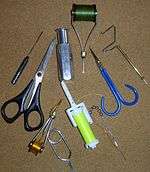
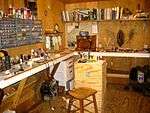
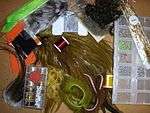
Various tools enable and optimize fly tying. Skip Morris, a professional fly tyer, lists the essential tools as being a vise to hold the hook of the fly to be tied, bobbins, a magnifying glass for delicate work, hackle pliers, hackle gauges, lights, hair stackers, and scissors. Other optional tools are pliers, toothpicks, bodkins, dubbing twisters, blenders, floss bobbins, whip finishers, wing burners and bobbin threaders.[12]
Materials
Fly tying material can be anything used to construct a fly on a hook. Traditional materials were threads, yarns, furs, feathers, hair, tinsels, cork, balsa and wire. Today's materials include not only all sorts of natural and dyed furs, hair and feathers, but also a wide array of synthetic materials. Rabbit, mink, muskrat, fox, bear, squirrel and other furs, deer, elk, moose hair and chicken, pheasant, turkey, duck, goose and partridge feathers are commonly incorporated into artificial flies. Chicken neck and saddle hackle, so essential for many artificial fly patterns, are from animals especially bred to produce hackles of superior performance and color. Synthetics have allowed fly tyers to replicate rare and sometimes endangered furs and feathers as well as create completely new types of flies. Synthetics such as rubber legs, plastic wings and transparent plastic cords, chenilles, and all sorts and colors of flashy materials that can be incorporated into the wings and bodies of today's artificial fly are available to the 21st-century fly tyer. Whereas lead wire was the traditional method of weighting flies, today's weighting materials include glass, brass and tungsten beads and cones as well as lead. Silicone, epoxy, kevlar thread and other modern materials are regularly incorporated in artificial fly patterns.[13][14]
Hooks
The hook determines the basic size and shape of each fly and is generally an important part of any fly pattern description. Hooks come in a wide range of size, shape, length and weight, and must be selected to complement the pattern being tied and the method by which it will be fished. Additionally, flies constructed for use in salt water are typically tied on corrosion-resistant hooks.
The fly pattern
The fly pattern is the recipe for any particularly named fly. In older literature, especially prior to the 20th century, fly patterns were referred to as dressings. The pattern specifies the size range and type of hook to be used, materials including type, color and size, and in some cases specific instructions to achieve a particular effect or configuration. Fly patterns allow tyers to consistently reproduce any given fly over time. A Light Cahill dry fly produced by one tyer will look remarkably similar to the same fly produced by a completely different tyer if the pattern is followed with reasonable accuracy and with comparable materials. Patterns may also lay out alternatives for different materials and variations.
Fly patterns are usually found in fly-fishing and fly-tying literature and periodicals, including online sources. Although fly patterns do provide some consistency, different writers may publish patterns with small to moderate differences across pattern descriptions for the same fly. In many cases, greatest differences are in the tying technique rather than in the form, color or materials. Fly patterns may or may not have an image or drawing of the finished fly to guide the tyer. Historically, fly patterns have been included in texts that discuss fishing with a particular genre of fly, fly-fishing technique or fly-fishing for specific species or genre of gamefish. There are, however, texts that are pure fly pattern and tying references with little or no instruction on how to fish them.
Parts of an artificial fly
Salmon flies have historically been the most complex and gaudy of artificial flies. Texts describing fly tying techniques often use an image of a salmon fly to describe all the parts of an artificial fly. The parts described below are typical.
Parts of a salmon fly[15] |
Key to Parts of Salmon Fly Image
|
Fly names
There is no convention or consistency in the naming of artificial flies. Long-standing popular patterns have names that have persisted over time. However, fly designers and amateur or professional fly tyers are free to create any fly they choose and to give it any name they want. Angling writers, the popular angling press, and professional fly tackle dealers have always introduced new patterns with new names. The only naming convention is that there is no convention. Flies have been named to honor or celebrate fellow anglers: Royal Wulff, Jock Scott, Quill Gordon, Adams; named to describe their color and composition: Ginger Quill, Gold-ribbed Hare's Ear, Partridge and Orange; named to reflect some regional origin: Bow River Bugger, Tellico nymph, San Juan worm; named to reflect the prey they represent: Golden stone, Blue-wing Olive, Pale Morning Dun, Elk Hair Caddis, White swimming shrimp; named to reflect nothing in particular: Woolly Bugger, Crazy Charlie, Club Sandwich; and, more often than not, named to evoke the designer: Copper John nymph (John Barr), Clouser Deep Minnow (Bob Clouser), Brooks' Montana stone (Charles Brooks), Parks' Salmonfly (Merton Parks), Carey Special (Colonel Carey), Dahlberg Diver (Larry Dahlberg) or Dave's Hopper (Dave Whitlock).
The following is an example of how flies get their names and how those names evolve over time.
- The Coachman
Most famous of all trout flies is the Coachman, originated by Tom Bosworth, who drove Queen Victoria's coach[16]
- The Royal Coachman
The Royal Coachman was first made by John Haily a professional fly dresser living in New York City. In writing of other matters, he enclosed this fly for us to see, saying "A gentleman wanted me to tie up some Coachman for him to take to the north woods and to make them extra strong, so I have tied them with a little band of silk in the middle to prevent the peacock bodies from fraying out. I have also added a tail of the barred feathers of the wood-duck, and I think it makes a very handsome fly." A few evenings later, a circle of us were together "disputing the fly in question", one of the party claiming that numbers were "quite as suitable to designate the flies as so many nonsensical names". The others did not agree with him, but he said: "What can you do? Here is a fly intended to be a Coachman; but it is not the true Coachman; it is quite unlike it and what can you call it?" Mr. L. C. Orvis, brother of Mr. Charles Orvis, who was present said: "Oh that is easy enough; call it the Royal Coachman it is so finely dressed!" And this name in time came to be known and used by all who are familiar with the fly.[17]
- The Royal Wulff
I will be forever indebted to Dan [Dan Bailey] for his companionship and inspiration. Indebted, too, because it was Dan who insisted on giving my name to the Wulff Series and gave me stature I might never have had otherwise. We were fishing together on the Esopus in the spring of 1930 when I was trying out some new flies I'd designed in revolt to the then available Catskill patterns. The new flies had bucktail wings and tails for better flotation. I had planned to call one of them the Bucktail Coachman. It was Dan who insisted that I call them Wulffs and he started tying them under that name— Lee Wulff in the tribute in Mist on the River-Remembrances of Dan Bailey.[18]
Typical fly patterns or dressing descriptions
The typical fly pattern appears something like one of the illustrative patterns below for the Adams dry fly (without tying instructions) or the Clouser Deep Minnow (with tying instructions). Based on the fly pattern, a knowledgeable fly tyer can reproduce the fly with the materials specified.
| Typical Fly Pattern Descriptions | |
|---|---|
| Fly | Pattern |
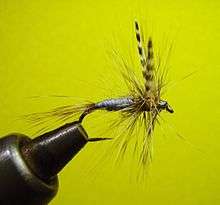 #10 Adams dry fly |
|
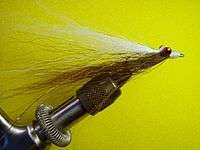 Clouser Deep Minnow Streamer |
|
Fly pattern types
Historically, fly pattern types have evolved along with fly fishing itself and today there are generally recognized pattern types. However, none are absolute, as there is much crossover in patterns and pattern types. Typically the fly tyer will encounter patterns classified as dry flies, wet flies, soft hackles, emergers, nymphs, terrestrials, bucktails and streamers, salmon (Atlantic) flies, steelhead and salmon (Pacific) flies, bass flies and bugs, poppers, panfish flies, saltwater flies, or pike flies. Even within these categories, there can be many sub-categories of imitative and non-imitative flies.
Further reading
- Ronalds, Alfred (1836). The Fly-Fisher's Entomology. London: Longman, Orme, Brown, Green and Longmans.
- Blacker, William (1855). Blacker's Art of Fly Making. London: Geo Nichols.
- Halford, F. M. (1886). Floating Flies and How to Dress Them. A Treatise on the Most Modern Methods of Dressing Artificial Flies for Trout and Grayling with Full Illustrated Directions and Containing Ninety Hand-Coloured Engravings of the Most Killing Patterns Together with a Few Hints to Dry-Fly Fishermen. London: Sampson, Low, Marston, Searle, and Rivington.
- Pritt, Thomas E. (1885). Yorkshire Trout Flies. Leeds: Goodall and Suddick.
- Ogden, James (1887). Ogden on Fly Tying, Etc. London: Sampson Low, Marston, Searle & Rivington.
- Theakston, Michael; Walbran, Francis M. (1888). British Angling Flies. London: Sampson Low, Marston, Searle, and Rivington.
- Marbury, Mary Orvis (1892). Favorite Flies and Their Histories. Boston and New York: Houghton and Mifflin Company.
- Kelson, George M. (1895). The Salmon Fly-How To Dress It and How to Use It. London: Wyman & Sons, Limited.
- West, Leonard (1913). The Natural Trout Fly and Its Imitation. Ravenshead, St Helens: McCorquodale & Co., Ltd.
- Pryce-Tannatt, T. E. (1914). How To Dress Salmon Flies-A Handbook for Amateurs (PDF). London: Adam and Charles Black.
- Rhead, Louis (1919). American Trout Stream Insects-A Guide to Angling Flies and other Aquatic Insects Alluring to Trout. New York: Frederick A. Stokes and Co.
- McClelland, H. G. (1919). The Trout Fly Dresser's Cabinet of Devices or How To Tie Flies for Trout and Grayling Fishing. London: The Fishing Gazette.
- Jennings, Preston J. (1935). A Book of Trout Flies. New York: Crown Publishers, Derrydale Press.
- Marinaro, Vincent C. (1950). A Modern Dry Fly Code. New York: G. P. Putnam Sons. ISBN 1-55821-413-5.
- Harris, J. R. (1952). An Angler's Entomology. London: Collins. ISBN 978-0007308187. New Naturalist #23
- Schwiebert, Ernest G. Jr. (1955). Matching The Hatch-A Practical Guide to Imitation of Insects Found On Eastern and Western Trout Waters. Toronto, Canada: The MacMillan Company.
- Shaw, Helen (1963). Fly-tying—Materials, Tools and Techniques. New York: The Ronald Press Company.
- Bates, Joseph D. (1966). Streamer Fly Tying & Fishing. Harrisburg, PA: Stackpole Books.
- Flick, Arthur B. (1967). The New Streamside Guide to Naturals and their Imitations. New York: Crown Publishers Inc.
- Bates, Joseph D. (1970). Atlantic Salmon Flies and Fishing. Harrisburg, PA: Stackpole Books. ISBN 0-8117-0180-8.
- Richards, Carl; Swisher, Doug (1971). Selective Trout-A Dramatically New and Scientific Approach to Trout Fishing on Eastern and Western Rivers. New York: Crown Publishers.
- Schwiebert, Ernest (1973). Nymphs-A Complete Guide to Naturals and Imitations. New York: Winchester Press. ISBN 0-87691-074-6.
- Wakeford, Jacqueline (1992). Fly Tying Tools and Materials. New York: Lyons & Burford Publishers. ISBN 1-55821-183-7.
- Stewart, Dick; Allen, Farrow (1993). Flies for Trout. New York: Lyons & Burford. ISBN 0-936644-14-1.
- Schmookler, Paul; Sils, Ingrid V. (1994). Rare and Unusual Fly Tying Materials-A Natural History Volume 1 – Birds. Mills, MA: The Complete Sportsman. ISBN 1-886961-01-8.
- Schmookler, Paul; Sils, Ingrid V. (1997). Rare and Unusual Fly Tying Materials-A Natural History Volume 2 – Birds and Mammals. Mills, MA: The Complete Sportsman. ISBN 1-886961-02-6.
- Hughes, Dave (1999). Trout Flies-The Tier's Reference. Mechanicsburg, PA: Stackpole Books. ISBN 978-0-8117-1601-7.
- Rosenbauer, Tom (2001). The Orvis Fly Tying Guide. New York: The Lyons Press. ISBN 1-58574-033-0.
- Clouser, Bob (2006). Clouser's Flies. Mechanicsburg, PA: Stackpole Books. ISBN 0-8117-0148-4.
- Soucie, Gary (2006). Woolly Wisdom. Portland, Oregon: Frank Amato Publications. ISBN 1-57188-352-5.
- Greenhalgh, Malcolm; Jason Smalley (2009). Fishing Flies: A World Encyclopedia of Every Type of Fly. London: HarperCollins Publishers. ISBN 978-0-00-728845-8.
References
- Shaw, Helen (1963). Fly-tying—Materials, Tools and Techniques. New York: The Ronald Press Company. iii..
- Wakeford, Jacqueline (1992). Fly Tying Tools and Materials. New York: Lyons & Burford Publishers. p. reface. ISBN 1-55821-183-7.
- Best, A. K. (1989). Production Fly Tying. Boulder, Colorado: Pruett Publishing Company. Forward. ISBN 0-87108-781-2.
- Gregg, E. C. (1940). How To Tie Flies. New York: A. S. Barnes and Company. vii.
- Best, A. K. (1989). Production Fly Tying. Boulder, Colorado: Pruett Publishing Company. ISBN 0-87108-781-2.
- Jennings, Preston J. (1935). A Book of Trout Flies. New York: Crown Publishers, Derrydale Press.
- Wade, Henry (1860). Rod-Fishing in Clear Waters By Fly, Minnow and Work With a Short and Easy method to the Art of Dressing Flies. London: Bell and Daldy.
- Ogden, James (1887). Ogden on Fly Tying, Etc. London: Sampson Low, Marston, Searle & Rivington. p. vi.
- McClelland, H. G. (1919). The Trout Fly Dresser's Cabinet of Devices or How To Tie Flies for Trout and Grayling Fishing. London: The Fishing Gazette. p. 63.
- Wade, Henry (1860). Rod-Fishing in Clear Waters By Fly, Minnow and Work With a Short and Easy method to the Art of Dressing Flies. London: Bell and Daldy. p. 132.
- Schullery, Paul (1996). American Fly Fishing-A History. Norwalk, CT: The Easton Press. pp. 85–99, 228–234.
- Morris, Skip (1992). Fly Tying Made Clear and Simple. Portland, OR: Frank Amato Publications. ISBN 1-878175-13-0.
- Wakeford, Jacqueline (1992). Fly Tying Tools and Materials. New York: Lyons & Burford Publishers. ISBN 1-55821-183-7.
- Morris, Skip (1992). Fly Tying Made Clear and Simple. Portland, OR: Frank Amato Publications. ISBN 1-878175-13-0.
- Kelson, George M. (1895). The Salmon Fly-HOW TO DRESS IT AND HOW TO USE IT. London: Wyman and Sons Ltd. pp. 17–18.
- McDonald, John (1972). Quill Gordon. New York: Alfred A. Knopf. p. late 5. ISBN 0-394-46989-5.
- Marbury, Mary Orvis (1892). Favorite Flies and Their Histories. Boston and New York: Houghton and Mifflin Company. p. 97.
- Waterman, Charles F. (1986). Mist on the River-Remembrances of Dan Bailey. Livingston, MT: Yellowstone Press. p. x. ISBN 0-9617253-0-3.
- Stewart, Dick; Allen, Farrow (1993). Flies for Trout. New York: Lyons & Burford. p. 2. ISBN 0-936644-14-1.
| Wikimedia Commons has media related to :Category:Fly tying. |
